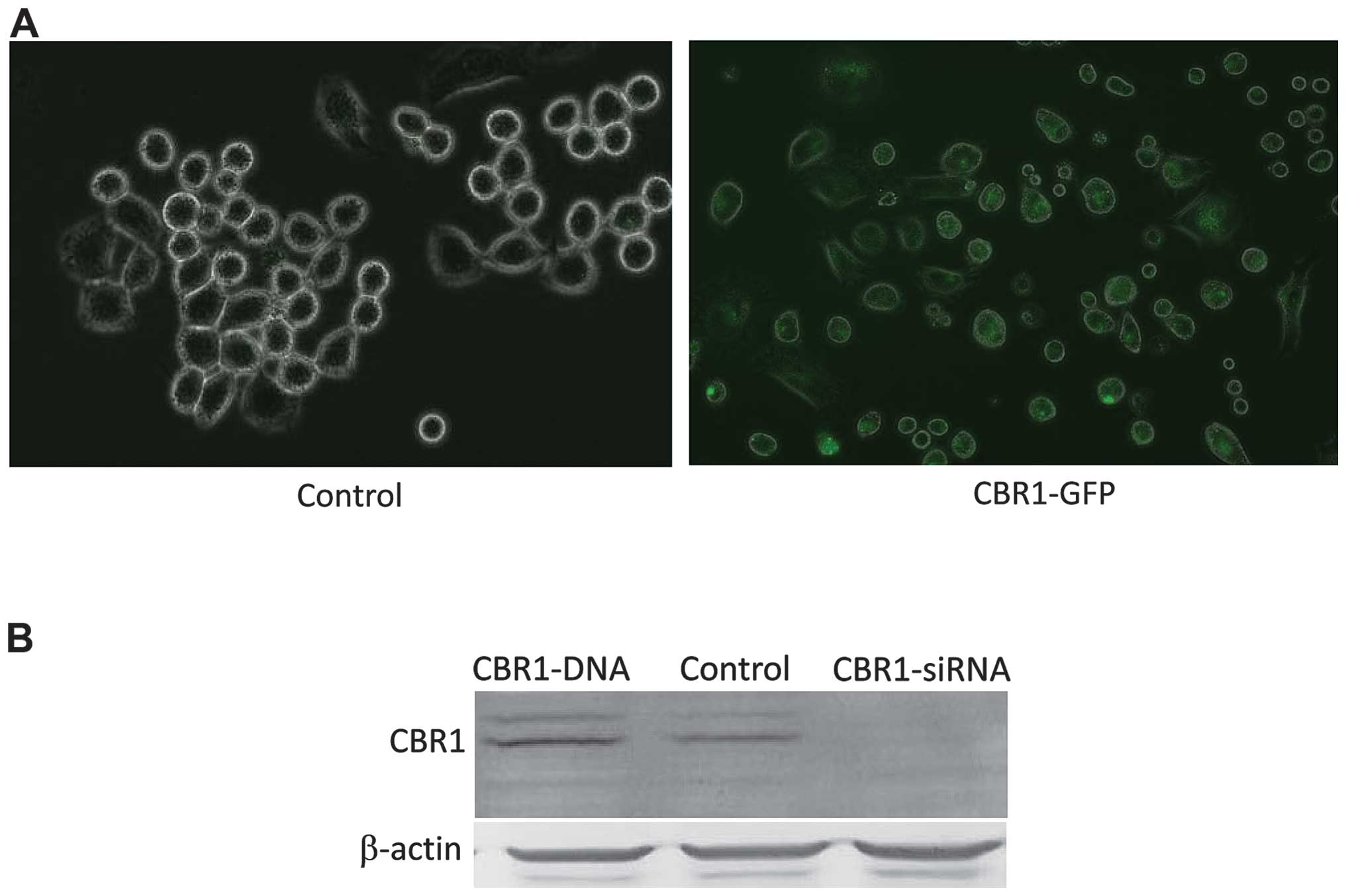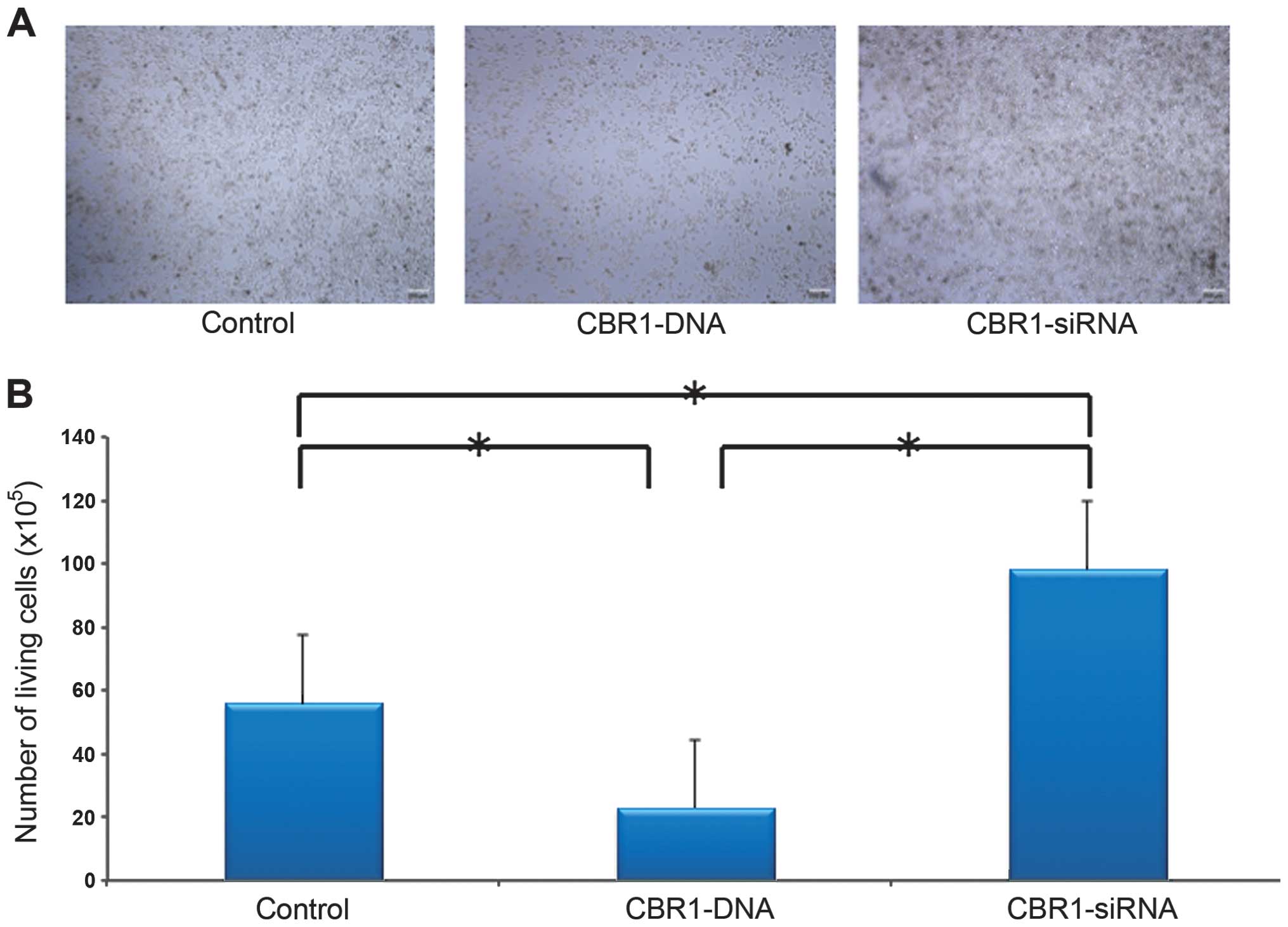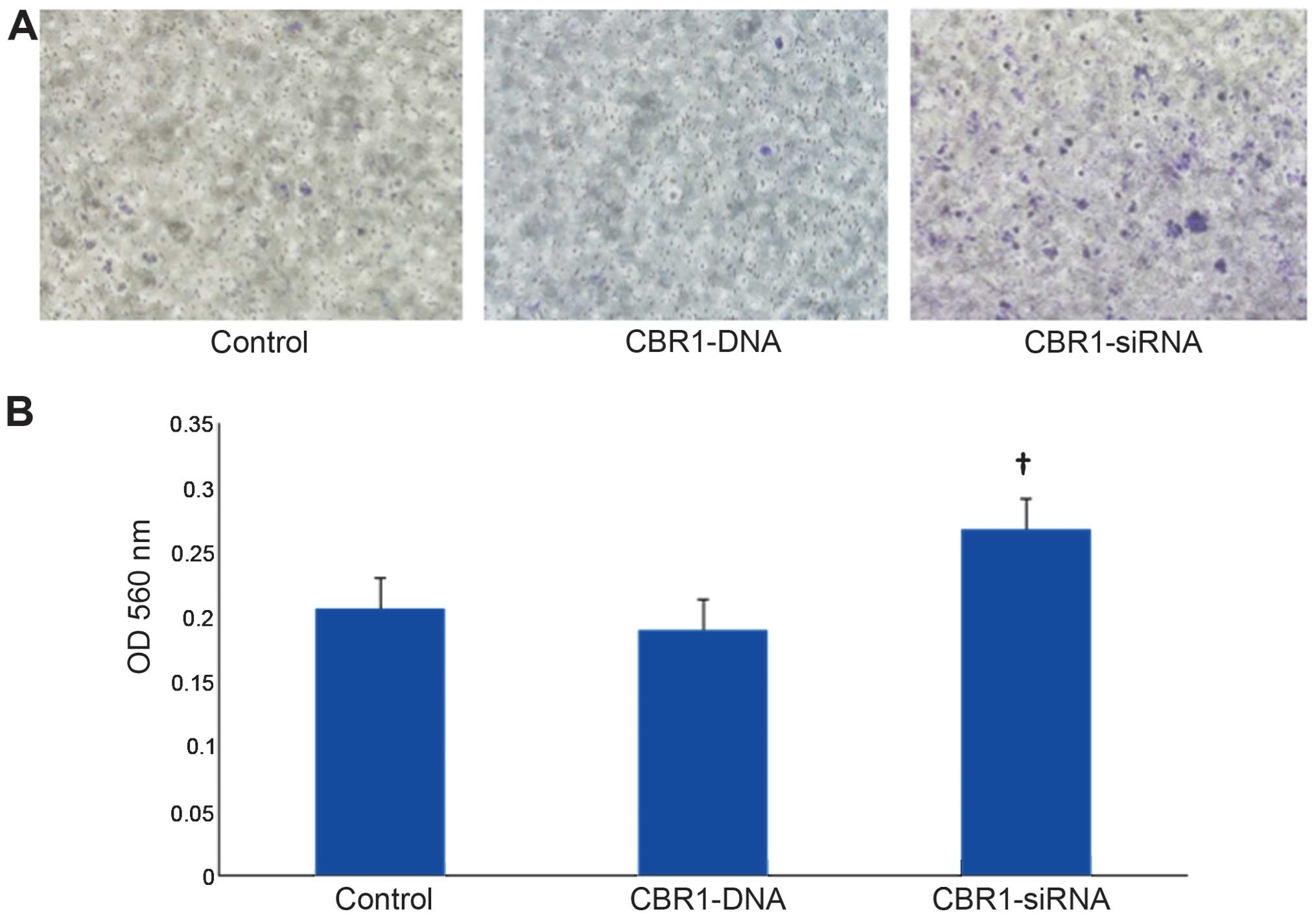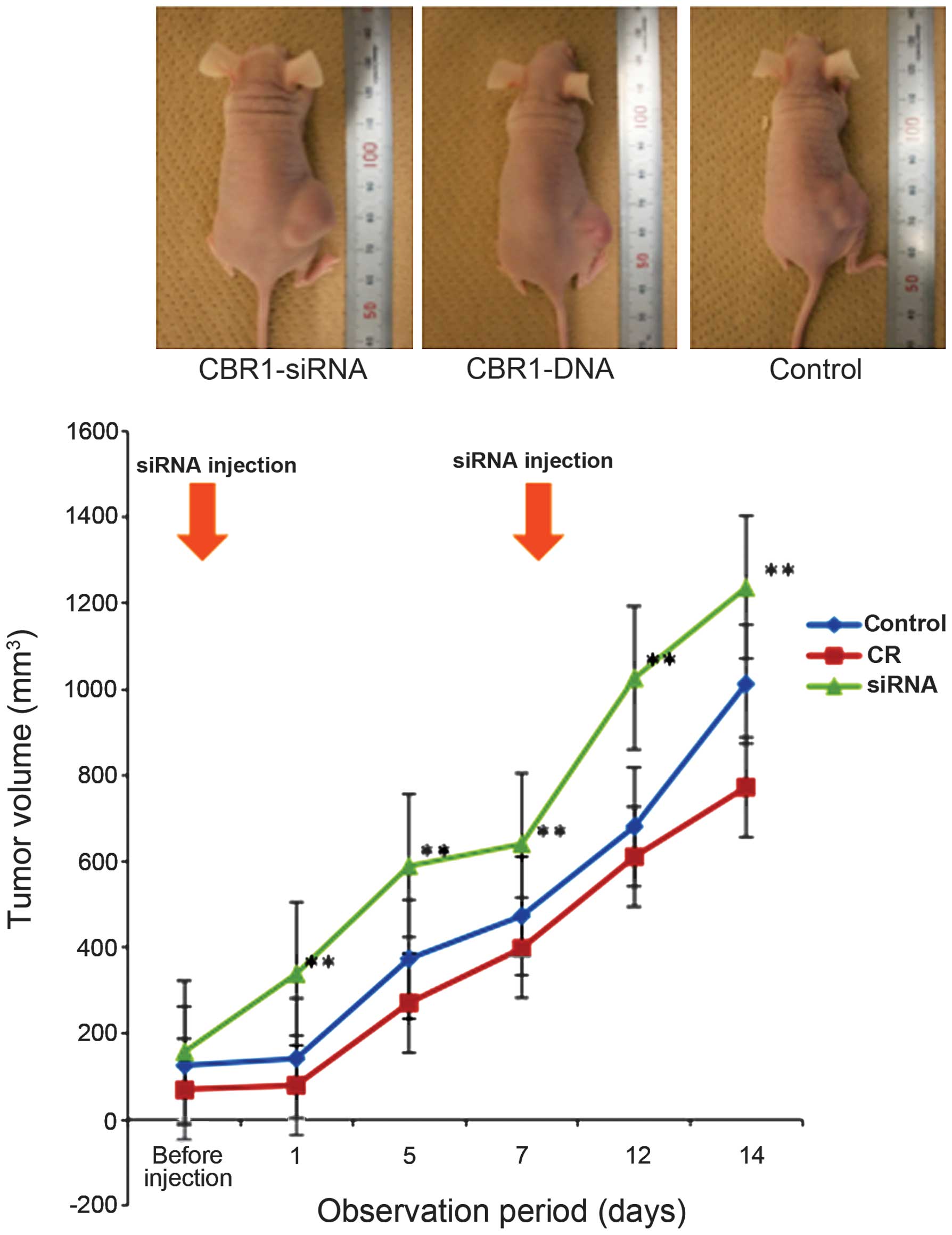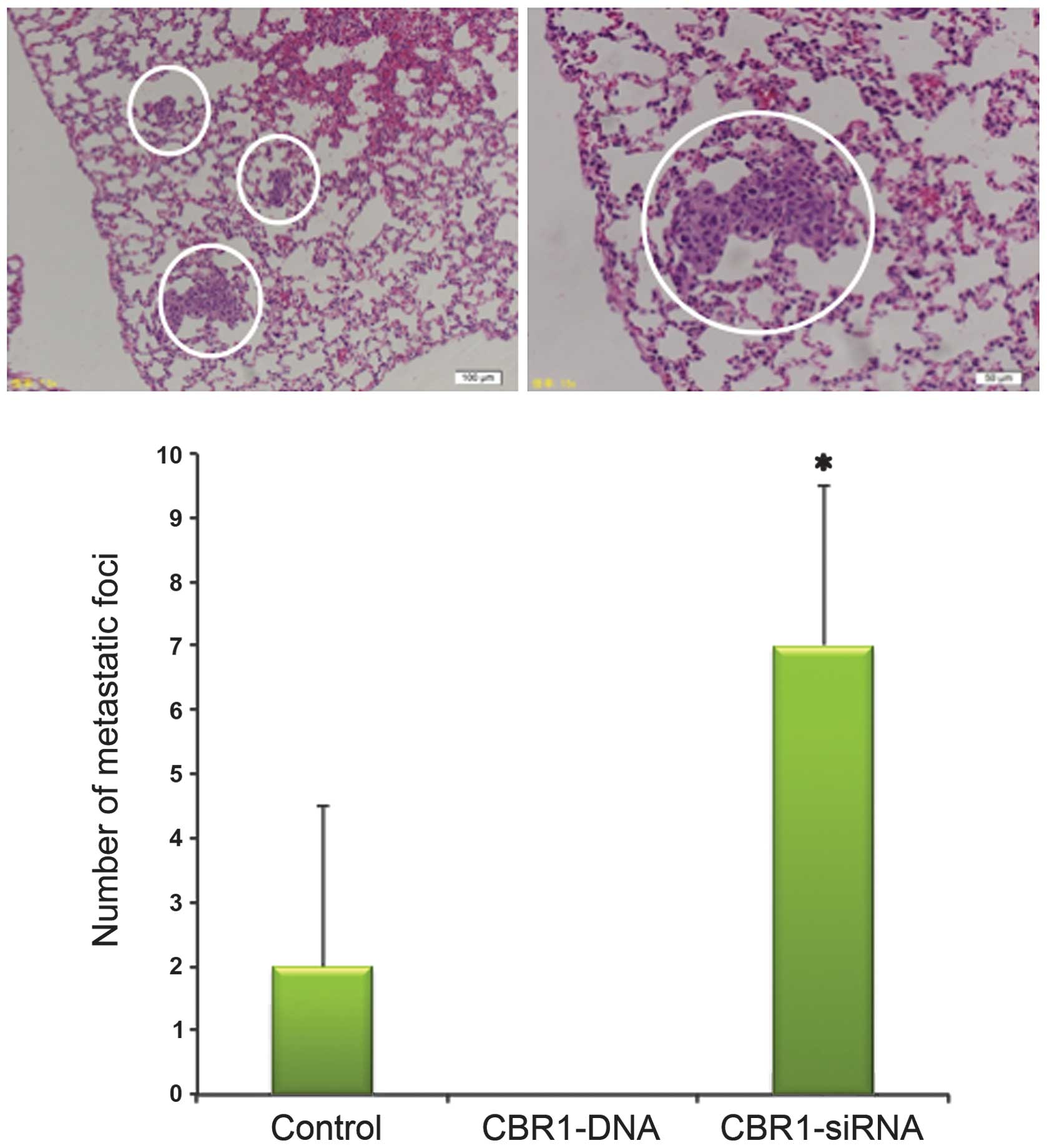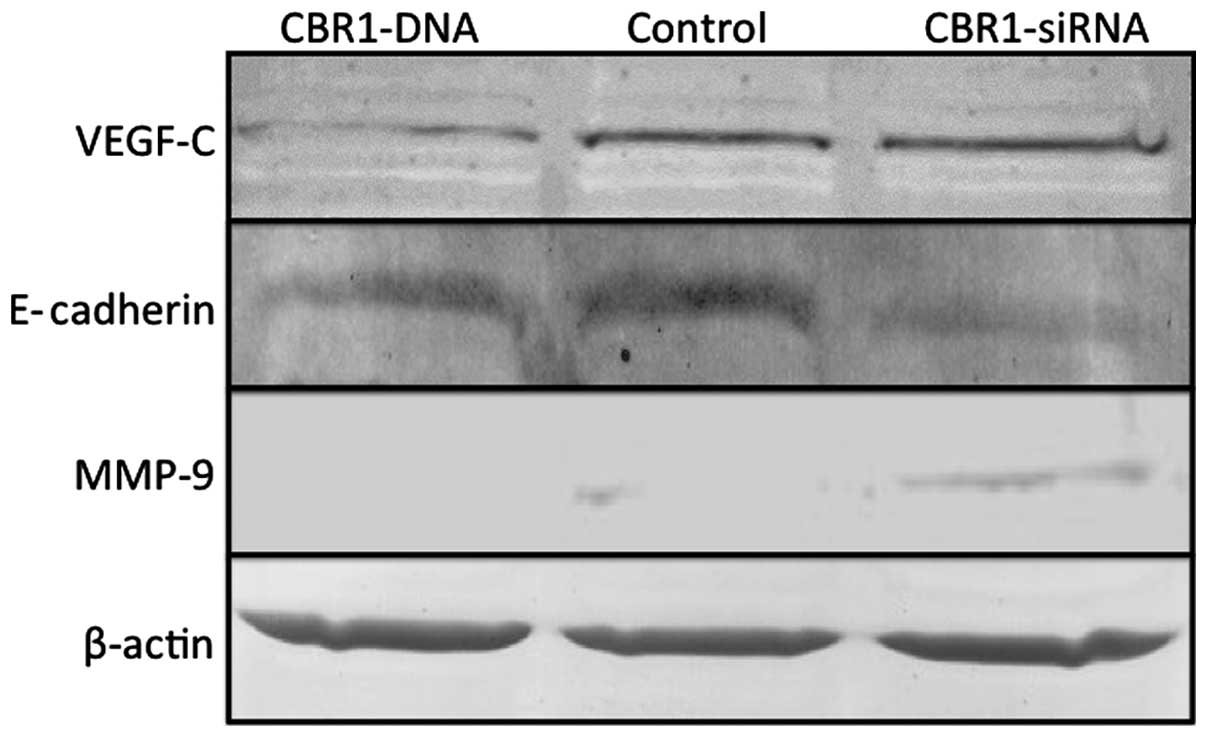|
1
|
Siegel R, Naishadham D and Jemal A: Cancer
statistics, 2013. CA Cancer J Clin. 63:11–30. 2013. View Article : Google Scholar : PubMed/NCBI
|
|
2
|
Heintz AP, Odicino F, Maisonneuve P, et
al: Carcinoma of the ovary. FIGO 26th Annual Report on the Results
of Treatment in Gynecological Cancer. Int J Gynaecol Obstet.
95(Suppl 1): S161–S192. 2006. View Article : Google Scholar : PubMed/NCBI
|
|
3
|
Yokoyama Y, Futagami M, Watanabe J, et al:
Redistribution of resistance and sensitivity to platinum during the
observation period following treatment of epithelial ovarian
cancer. Mol Clin Oncol. 2:212–218. 2014.PubMed/NCBI
|
|
4
|
Gonzalez-Covarrubias V, Ghosh D, Lakhman
SS, Pendyala L and Blanco JG: A functional genetic polymorphism on
human carbonyl reductase 1 (CBR1 V88I) impacts on catalytic
activity and NADPH binding affinity. Drug Metab Dispos. 35:973–980.
2007. View Article : Google Scholar : PubMed/NCBI
|
|
5
|
Wermuth B, Bohren KM, Heinemann G, von
Warthburg JP and Gabbay KH: Human carbonyl reductase. Nucleotide
sequence analysis of a cDNA and amino acid sequence of the encoded
protein. J Biol Chem. 263:16185–16188. 1988.PubMed/NCBI
|
|
6
|
Plebuch M, Soldan M, Hungerer C, Koch L
and Maser E: Increased resistance of tumor cells to daunorubicin
after transfection of cDNAs coding for anthracycline inactivating
enzymes. Cancer Lett. 255:49–56. 2007. View Article : Google Scholar : PubMed/NCBI
|
|
7
|
Olson LE, Bedja D, Alvey SJ, Cardounel AJ,
Gabrielson KL and Reeves RH: Protection from doxorubicin-induced
cardiac toxicity in mice with a null allele of carbonyl reductase
1. Cancer Res. 63:6602–6606. 2003.PubMed/NCBI
|
|
8
|
Schieber A, Frank RW and Ghisla S:
Purification and properties of prostaglandin 9-ketoreductase from
pig and human kidney. Identity with human carbonyl reductase. Eur J
Biochem. 206:491–502. 1992. View Article : Google Scholar : PubMed/NCBI
|
|
9
|
Waclawik A and Ziecik AJ: Differential
expression of prostaglandin (PG) synthesis enzymes in conceptus
during peri-implantation period and endometrial expression of
carbonyl reductase/PG 9-ketoreductase in the pig. J Endocrinol.
194:499–510. 2007. View Article : Google Scholar : PubMed/NCBI
|
|
10
|
Sheng H, Shao J, Morrow JD, Beauchamp RD
and DuBois RN: Modulation of apoptosis and Bcl-2 expression by
prostaglandin E2 in human colon cancer cells. Cancer Res.
58:362–366. 1998.PubMed/NCBI
|
|
11
|
Tsujii M, Kawano S, Tsuji S, Sawaoka H,
Hori M and DuBois RN: Cyclooxygenase regulates angiogenesis induced
by colon cancer cells. Cell. 93:705–716. 1998. View Article : Google Scholar : PubMed/NCBI
|
|
12
|
Murakami A, Fukushima C, Yoshidomi K, et
al: Suppression of carbonyl reductase expression enhances malignant
behaviour in uterine cervical squamous cell carcinoma: carbonyl
reductase predicts prognosis and lymph node metastasis. Cancer
Lett. 311:77–84. 2011. View Article : Google Scholar : PubMed/NCBI
|
|
13
|
Murakami A, Yakabe K, Yoshidomi K, et al:
Decreased carbonyl reductase 1 expression promotes malignant
behaviours by induction of epithelial mesenchymal transition and
its clinical significance. Cancer Lett. 323:69–76. 2012. View Article : Google Scholar : PubMed/NCBI
|
|
14
|
Umemoto M, Yokoyama Y, Sato S, Tsuchida S,
Al-Mulla F and Saito Y: Carbonyl reductase as a significant
predictor of survival and lymph node metastasis in epithelial
ovarian cancer. Br J Cancer. 85:1032–1036. 2001. View Article : Google Scholar : PubMed/NCBI
|
|
15
|
Wang H, Yokoyama Y, Tsuchida S and
Mizunuma H: Malignant ovarian tumors with induced expression of
carbonyl reductase show spontaneous regression. Clin Med Insights
Oncol. 6:107–115. 2012.PubMed/NCBI
|
|
16
|
Yokoyama Y, Xin B, Shigeto T, et al:
Clofibric acid, a peroxisome proliferator-activated receptor alpha
ligand, inhibits growth of human ovarian cancer. Mol Cancer Ther.
6:1379–1386. 2007. View Article : Google Scholar : PubMed/NCBI
|
|
17
|
Yang J and Weinberg RA:
Epithelial-mesenchymal transition: at the crossroads of development
and tumor metastasis. Dev Cell. 14:818–829. 2008. View Article : Google Scholar : PubMed/NCBI
|
|
18
|
Alshenawy HA: Immunohistochemical
expression of epidermal growth factor receptor, E-cadherin, and
matrix metalloproteinase-9 in ovarian epithelial cancer and
relation to patient deaths. Ann Diagn Pathol. 14:387–395. 2010.
View Article : Google Scholar : PubMed/NCBI
|
|
19
|
Wakui M, Yokoyama Y, Wang H, Shigeto T,
Futagami M and Mizunuma H: Efficacy of a methyl ester of
5-aminolevulinic acid in photodynamic therapy for ovarian cancers.
J Cancer Res Clin Oncol. 136:1143–1150. 2010. View Article : Google Scholar : PubMed/NCBI
|
|
20
|
Ismail E, Al-Mulla F, Tsuchida S, et al:
Carbonyl reductase: a novel metastasis-modulating function. Cancer
Res. 60:1173–1176. 2000.PubMed/NCBI
|
|
21
|
Cano A, Pérez-Moreno MA, Rodrigo I, et al:
The transcription factor snail controls epithelial-mesenchymal
transitions by repressing E-cadherin expression. Nat Cell Biol.
2:76–83. 2000. View
Article : Google Scholar : PubMed/NCBI
|
|
22
|
Li LN, Zhou X, Gu Y and Yan J: Prognostic
value of MMP-9 in ovarian cancer: a meta-analysis. Asian Pac J
Cancer Prev. 14:4107–4113. 2013. View Article : Google Scholar : PubMed/NCBI
|
|
23
|
Ozalp S, Tanir HM, Yalcin OT, Kabukcuoglu
S, Oner U and Uray M: Prognostic value of matrix
metalloproteinase-9 (gelatinase-B) expression in epithelial ovarian
tumors. Eur J Gynaecol Oncol. 24:417–420. 2003.PubMed/NCBI
|
|
24
|
Sillanpää S, Anttila M, Voutilainen K, et
al: Prognostic significance of matrix metalloproteinase-9 (MMP-9)
in epithelial ovarian cancer. Gynecol Oncol. 104:296–303. 2007.
View Article : Google Scholar
|
|
25
|
Cowden Dahl KD, Symowicz J, Ning Y, et al:
Matrix metalloproteinase 9 is a mediator of epidermal growth
factor-dependent e-cadherin loss in ovarian carcinoma cells. Cancer
Res. 68:4606–4613. 2008. View Article : Google Scholar : PubMed/NCBI
|
|
26
|
Yokoyama Y, Charnock-Jones DS, Licence D,
et al: Vascular endothelial growth factor-D is an independent
prognostic factor in epithelial ovarian carcinoma. Br J Cancer.
88:237–244. 2003. View Article : Google Scholar : PubMed/NCBI
|
|
27
|
Tammela T and Alitalo K:
Lymphangiogenesis: molecular mechanisms and future promise. Cell.
140:460–476. 2010. View Article : Google Scholar : PubMed/NCBI
|
|
28
|
Abbasi MM, Monfaredan A, Hamishehkar H,
Seidi K and Jahanban-Esfahlan R: Novel DOX-MTX nanoparticles
improve oral SCC clinical outcome by down regulation of lymph
dissemination factor VEGF-C expression in vivo: oral and IV
modalities. Asian Pac J Cancer Prev. 15:6227–6232. 2014. View Article : Google Scholar : PubMed/NCBI
|
|
29
|
Ikeda K, Oki E, Saeki H, et al:
Intratumoral lymphangiogenesis and prognostic significance of VEGFC
expression in gastric cancer. Anticancer Res. 34:3911–3915.
2014.PubMed/NCBI
|
|
30
|
Gyftopoulos K, Lilis I, Kourea H and
Papadaki H: The expression of vascular endothelial growth factor-C
correlates with lymphatic microvessel density and lymph node
metastasis in prostate carcinoma: an immunohistochemical study.
Urol Ann. 6:224–230. 2014. View Article : Google Scholar
|
|
31
|
Peppicelli S, Bianchini F and Calorini L:
Inflammatory cytokines induce vascular endothelial growth factor-C
expression in melanoma-associated macrophages and stimulate
melanoma lymph node metastasis. Oncol Lett. 8:1133–1138.
2014.PubMed/NCBI
|



